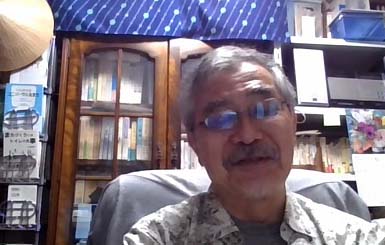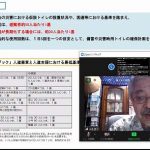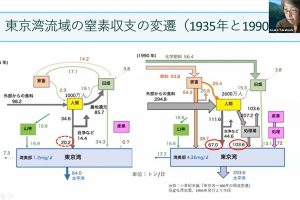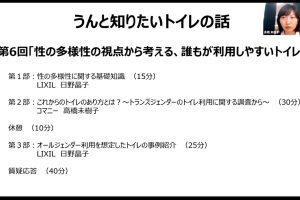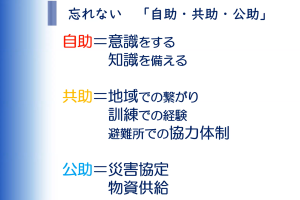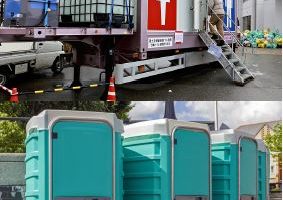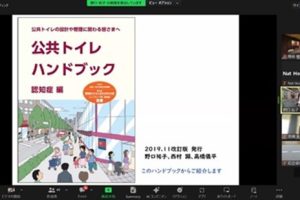Title: The 4th seminar “Disasters and toilets -2″
Date: 22 July 2021 (Thu) 18:00-20:00 JST
Presenter:
Kohei Yamamoto, Deputy Chairperson of Japan Toilet Association (JTA)
【Presenter Introduction】
I am running a waste and environmental consultant company and the vice chairman of the Japan Toilet Association (JTA). Nearly 40 years ago, Japanese toilets were horrible. Then we started a Toilet Pia Party. One year later, we started the Japan Toilet Association in 1985 with public spirited persons. I was a general secretary for 10 years, and we organized the National Toilet Symposium named “Good Toilet 10 (Ten)”, where JTA selects the best ten good toilets in Japan every year. The International Toilet Symposium was held in Kobe in 1993 and it must be the first international toilet conference in the world.
【Hanshin-Awaji Earthquakes Disaster】
I graduated from university and worked at Kobe municipal office for six years. There happened Hanshin-Awaji Great Earthquakes in 1995. I felt actually it because my wife parents’ house was completely collapsed.
At that time, Kobe city was advanced in the sewerage and toilet systems and there were flush toilets in most of the houses. After the earthquakes, the restoration of water and sewerage services were relatively slower than the electricity services. It took a very long time to recover from the damage to the sewage treatment facility. In fact the water supply was disconnected for about three months.
Kobe city did not anticipate a big earthquakes disaster and was inadequately prepared for it. At that time, many volunteers gathered to Kobe and since then disaster volunteer activities became popular. Tens of thousands of people gathered at some evacuation centers and the elementary schools and there happened a big mess eventually.
We called everyone throughout Japan and started an action to recruit toilet volunteers. We did not know where and how many temporary toilets were in the evacuation center, and we could not set up a system for pumping, then we surveyed the needs of temporary toilets with Kobe city Environment Bureau. It is no point to do like “dig a hole and use it as a toilet” in an urban area. If you may dig a hole and fill a pail or bucket, it fills up quickly and there is no place to treat it then this is consequently useless.
Although many evacuees gathered at the center, Kobe city could not afford to prepare enough temporary toilets at first. The city asked to supply prefabricated disaster toilets from all Japan and also rented temporary toilets. It took about two weeks when about one toilet in 100 people was equipped and then their complaint finally subdued.
After the number of evacuees decreased it was found the optimum temporary toilet numbers must be about one for 70 people. In the toilets in the condominium, it is heard that the sewage spouted from the drain on the first floor by flowing water from the upper floors without noticing that the sewer pipe was broken.
Many school toilets at the evacuation centers were still Japanese crouching style toilets, then the city installed portable toilets. Although the sewage treatment facilities were severely damaged, the main sewage system was fortunately less damaged. As it could be drained when there was water which used from the pools or rivers in some areas.
【What we learned from the toilet problems at the disaster】
It is natural manner that the human beings excrete after eat or drink. It was fortunately cold season in winter at the time of the earthquakes. If this was happened in summer, various illnesses may have spread from the toilet. We realized that the toilets are the most essential objects for safety and life protection.
Furthermore, it was found that cares for the elderly, persons with disabilities, women, children, etc. were extremely insufficient. For instance when a user turn on the lights in a prefabricated temporary toilet in the night, the silhouette may be reflected outside, then it was hesitation to use. When there were large steps at the toilet entrance, it is difficult for elderly people with disabilities to use it often. It may seem that temporary toilets do not use water for pumping but the water for cleaning is always necessary.
The results of our research are that the temporary toilets were not delivered immediately and that at least one toilet is necessary for 70 to 100 people. This becomes the de-fact standard for disaster toilets in Japan. It turned out that cleaning tools are also necessary to be stockpiled.
Later at Great East Japan Earthquakes in 2011, the toilets were not delivered quickly, however it seems that there were less situations where everyone was in trouble about the toilets compared to the Hanshin-Awaji earthquakes in 1995. At the Kumamoto earthquakes in 2016, it has changed a form where Japanese national government started a push-type support to instruct to the industries, etc. to provide it before the request from the local governments.
What we learned through these experiences are,
1) Toilet facilities are more important than food or drinking water at disaster by the earthquakes disasters.
2) It seems that the government may be still unconscious about the importance on the stockpiling for it is not sufficiently prepared.
3) The quality issues are also important.
4) Basically, many temporary toilets are still Japanese crouching styles, and there are a few toilets for the people with disabilities such as wheelchair users.
5) There is also necessary to consider the cares for babies, toddlers and women.
6) The issues of toilets for volunteers are still not discussed well. There remains a serious problem that volunteers are prohibited to use the evacuation center toilets.
【Related law and legal system】
Basically “Disaster Countermeasures Basic Law” and “Disaster Relief Law” stipulate the evacuation shelters at a disaster. “A disaster prevention plan” is stipulated by “Basic Act on Disaster Countermeasures.” The national plan is based on “Disaster Prevention Basic Plan.” While the home house itself be habitable, people must stay at home. That is why the reason, water, food, and toilets must be stockpiled.
There are various shelter types. “Disaster Countermeasures Basic Law” stipulates that designated shelters are to be prepared as a general type of the shelter. When many people escape anyway, the place is called “A wide area evacuation site.” In Tokyo, there are now 213 places with about 10 hectares each. Perhaps tens of thousands of people escape there. It is said the current situation is that no concrete plans or maintenance for toilets and they are not yet fixed. The evacuation shelters are normally placed at the elementary schools. Those are places for those people who cannot return to their homes and then stay there for several days or months.
The welfare facilities are designated as the evacuation shelters for the elderly and persons with disabilities who are difficult to stay in the general evacuation shelters. A designated emergency shelter is an evacuation place where people rush to escape when a Tsunami approaches. There are many evacuation sites in Japan and people will escape there, however there are still toilet problems.
The Cabinet Office created the guidelines about toilet operations at the evacuation centers in 2016 after Great East Japan Earthquakes. According to international Sphere standards, the number of toilets required is one toilet for every 50 evacuees, and one toilet for every 20 evacuees when prolonged.
Schools can be transformed to shelters, however only less than half of them can use manhole toilets when water supply is cut off. There are still shortage of stockpiled toilets for evacuees.
In 2019 we took a questionnaire on the actual state of efforts of municipalities nationwide. 46 respondents said they had trouble with the toilet at the disaster.
55.7% of them said that the plan for the toilet was set in the regional disaster prevention plan, but 34% said that it was not yet set in particular. 64.5% of them preserve a stockpile of temporary toilets, but there is no confidence it is enough or not. Only about 30% of them have conducted the temporary toilet agreements with rental companies. More than 70% of them stockpiled portable toilets for the disaster prevention. There are many answers that they suggest the people in the town to prepare stockpiles in advance.
The big problem is the pumping filth in the temporary toilets and at most it is only vaguely written such that “Getting help somewhere, dealing with a wide area and coordinating with prefectures.” Only about 44% of the toilets for the elderly and disabled can be used in the schools and shelters. Western-style simple toilets by overlapping on Japanese crouching style toilets and indoor portable toilets are only 40% of the stockpiles and this is extremely insufficient.
There is a disaster waste treatment plan in Kita-ku, Tokyo where the amount of materials and equipment required are calculated for the used portable toilets process is planned. There are some advanced local governments like Kita-ku in Japan. Some local governments have created a disaster shelter toilet manual but rest of them have not prepared yet.
The first manhole toilet was designed by Kobe city on a trial at school, based on the experience of removing the manhole lid and setting up a tent over it from the experience of the Kobe earthquakes. At the time of the Kumamoto earthquakes, this type toilets were well used in many places.
NPO called “Helping each other in Japan” is promoting that the local government preserves mobile toilets and supplies each other at the time of disaster. 13 cities in Japan preserve this toilet now.
Different type of toilets are installed based on various laws. Since there are different toilet managers, there is no unified cleaning and maintenance know-hows. It must be necessary to centralize to care of toilets in the administration and manage all public toilets. It is necessary for local governments to set up an especial section to maintain toilets including the private toilets efficiently.
【Appendix】
Normally the drinking water is necessary to be 2.5 to 3 liters per person per day, but the water for washing and cleaning is also required. The Fire and Disaster Management Agency calculated that about 10 to 20 L per person per day as a guideline for the water supply. It is necessary to think about how to secure such a water. I am also a chairman of NPO called “Rainwater for Citizens Association.” The rainwater becomes purified by a hollow fiber membrane cartridge.
【Q&A】
Q1: Is there a simulation of toilet arrangement by using AI technology?
A1: I do not know about arranging toilets using AI yet. There is an indication of the location of the toilet. When people stay to evacuate in their own home, they must go and use a toilet outside because the home one is not available. There is also necessary to inform the toilets for volunteers who are prohibited to use the evacuating center toilet.
Q1: The temporary toilets must be placed in appropriate places avoiding a fire or road congestion. There must be a method for the government to use AI for the simulation of the earthquakes.
Q2: Even if the flush toilet could use, it did not happen the downstream sewer pipe broke or blew out?
A2: The water supply was cut off, but there was no serious damage at the main sewage system fortunately. In the case of Kobe, a sewage treatment plant was broken, then we partitioned the Osaka bay and temporarily poured disinfected sewage supernatant to the bay. It must be careful of the spouted the drain water at the lower floor when pouring it from the upper floor in the condominium.
Q3: In Japan there is a high performance single merger processing tank system. The combined septic tank requires electricity and water. They recover quickly at the disaster spot fortunately comparing that it will take 3 months for the centralized treatment plant to recover. It must be better to preserve a merged treatment tank in a big city.
A3: A pumping filth company of the Environmental Improvement Association in Gifu Prefecture rushed first to reach soon after the Kobe earthquakes because Kobe once helped them at the disaster of Nagoya Typhoon. At that time, while moving from Gifu to Kobe, they inquired the Ministry of Health and Welfare and got a permission that if the sewage treatment plant was broken and the excrement treatment was not possible, it is to dump them to Osaka Bay urgently.
I proposed Setagaya-ku, Tokyo to create a pit in the basement of a public toilet so that it could be pumped filth, however it was rejected by the cleaning bureau. The law stipulates that it is prohibited to set a toilet by pumping filth in an area equipped with sewerage treatment system. There exists a manhole toilet now but I think that a toilet by pumping filth is the most suitable way at the earthquakes disaster.
In other local governments, there are discussions that the old excrement treatment plant should be kept for the disaster. Since raw excrement cannot be put into a sewage treatment plant, it has been argued that a method by a base facility for diluting it with adding water and draining it into a sewage pipe which is called dilution discharge. This is not only the issues of the number of toilets, but also how to handle it and this problem has not been discussed well.
I think it would be possible when the idea comes out of creating a special toilet section in each local government with concentrating authority. When unified, it must be ideal to deal with not only disasters but also daily life about the toilets for people with disabilities and gender issues.
As for the actual problems of the disaster volunteer toilet, the volunteers are prohibited to use the toilet at the disaster volunteer center. They are recomended to drink plenty of water under the scorching sun. When they want to go to the toilet without toilet nearby, male volunteer may urinate in the open field. The reality is that they must hold until they return to the disaster volunteer center until lunch time. Overseas rescue teams and the Self-Defense Forces are equipped their own toilets.
Q4: South Korean municipality has a department to manage toilet matters centrally. There is a toilet section in Suwon city where the questioner visited. Others are not as enthusiastic as Suwon, but it can be said that there is a system to work when one special section for the toilets. There is a toilet law in South Korea, and the person in charge of the toilet is assigned in each municipality, then they can act swiftly for making arrangements in advance.
Q5: Someone informed the Self-Defense Forces prepare large toilet cars in each regional headquarters. Fire departments in cities with a population of more than 300,000 will preserve the toilet facilities for firefighters equipped in their command vehicles. The police department also prepared the toilet facilities especially for the riot cops in the prefectural police headquarters. The Ministry of Land, Infrastructure, Transport and Tourism preserved the staff toilets for front-line disaster supporters. The fire engine maker, Morita sells such type vehicles.
A5: The wheelchair and administrative issues are often discussed in general use toilets however it is not covered on the disaster toilets yet. I think this is because the different governmental sections are in charge for disaster toilets and public toilets. It is discussed about the toilets in regional disaster prevention plans and disaster waste treatment plans, however the problems of the public toilets at the disaster are not well covered. The preserving of Western-style toilets are slow in pace. It has been discussed the serious problem of toilets for disaster volunteers. I think it is necessary to discuss these issues gathering different field people.
